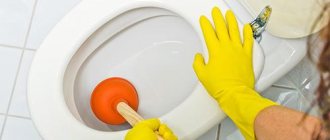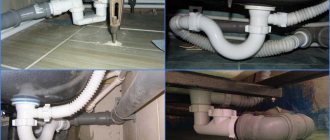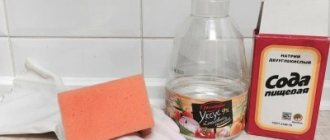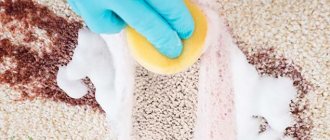Unfortunately, the toilet can become clogged. Just throw too much toilet paper at it and you're in trouble. It is worth remembering that a clogged drain will not allow water to flow through, if you continue to press the button despite the blockage, then after 3-4 drains you will expose the room to the risk of waste water overflowing and can flood the floor. Clogging can be a big problem. Although a regular plunger, in some cases, works well for clearing a drain, there are also other methods that allow you to solve the problem without special tools. How to unclog a toilet at home with a bottle, a plunger and folk remedies?
In most cases, simple remedies that are found in every home are sufficient to eliminate the problem, namely: dishwashing liquid, warm water, baking soda or vinegar. Below are methods for eliminating the problem at home using improvised means.
Liquid dish soap and warm water
The first method is to use two components:
- ordinary dishwashing liquid, which is found in every home;
- warm water.
The procedure is not complicated.
- Pour dishwashing liquid into standing water in the toilet.
- After about 20 minutes of letting the dish liquid settle to the bottom, pour a pan of warm water over the toilet paper that clogged the drain.
- After this, you should wait a little longer and drain the water.
The advantage of this home method is that it can be used in most cases. Note, however, that it is not 100% effective. Much depends on what is clogged with the drain. The method is quite effective if the passage is clogged with a paper towel. This material is slightly thicker than toilet paper and does not soften well in water, so it is a fairly common cause of clogged drains.
General principles of sewerage operation
The sewer system consists of a riser and pipelines that are designed to drain liquid waste from plumbing fixtures. The riser is a large diameter pipe and is usually located in the bathroom.
Modern risers are often made of plastic, but many houses still have cast iron pipes. The advantage of cast iron is strength, and plastic risers are less susceptible to blockages. Most often, old cast iron pipes become clogged. There are burrs on their inner walls, which causes deposits to quickly form.
To prevent air from the sewer from entering the room, a siphon is provided in the design of the toilet - a bend where a water plug (hydraulic seal) is constantly located. When flushing, water displaces and replaces this plug, pushing sewage from the toilet into the sewer riser.
If there is debris in the pipe and the water has not pushed it out into the riser, a clog may form. Scraps of paper, waste, hair, threads get caught on sharp or large objects. Gradually, all this turns into a large lump of dirt, which narrows or completely blocks the pipe section.
How to clear a clog with a plunger
One of the most popular and simplest methods is to use a plunger.
There are quite a few types of plungers on the market, each of them is designed to clear clogged drains of different diameters. Using a plunger is a very quick and effective method, and it is also quite easy. Simply insert the rubber tip into the drain hole, push down and pull up. The tool works very simply, it acts as a suction pump and produces a pumping alternating pressure that acts on the liquid. Usually we achieve the expected effect the first time.
The only problem is that, as a rule, we simply don’t have it in stock. Therefore, it is worth purchasing this simple and inexpensive device in advance “just in case,” even if you have not yet encountered this problem.
Removing the item
To gain access to the inside of the washing machine, first of all, you need to open the lower area of the structure where the heater is located. In some models, the heating element is located in the rear area of the machine
To do this, you need to unscrew the bolts on the back wall and carefully remove the panel. However, before carrying out all the manipulations, you need to disconnect the device from the power supply. Then you need to very carefully remove the TEN, having first unscrewed the nuts
This must be done so that in the process of searching for a foreign object, the user does not accidentally damage the integrity of the heating element. Once you have access to the hole, you can easily remove the bra wire from the washing machine
Then you need to very carefully remove the TEN, having first unscrewed the nuts. This must be done so that in the process of searching for a foreign object, the user does not accidentally damage the integrity of the heating element. Once you have access to the hole, you can easily remove the bra wire from the washing machine.
Cleaning with soda and vinegar
A good way is also to combine these two components. The first of these is baking soda, which is considered the most versatile household remedy. With its help you can clean almost the entire house, it will be useful when performing activities related to cleaning windows, carpets, silverware, irons or for removing odors from shoes. In combination with vinegar, soda is an “antidote” to clogged plumbing. How to clear clogs with soda? The first step is to add a few tablespoons of baking soda to the water, then add vinegar and wait a few minutes. Then simply rinse with water.
A short educational program from the plumber Uncle Misha
Before leaving, Uncle Misha shared some of the wisdom of his work, which we will tell the readers of sympaty.net about. Before you choose a method for unclogging a clogged toilet, you need to figure out why the blockage occurred.
- If the toilet is clogged due to an object getting into the drain, for example, a floor rag or a bag, then it is better to use a special plumbing cable (the one that Uncle Misha came with on his shoulder). The tip of the cable is inserted into the toilet and pushed forward, rotating in a circle strictly in one direction. If compaction is felt, a push is made. Most likely, this is where a foreign object is stuck. When the blockage is cleared, you need to pour boiling water into the toilet. We didn't have to use this method.
- To remove organic waste from the toilet, it is enough to use chemicals that will dissolve the resulting blockage. This method will be effective if the toilet is clogged with food debris.
- Well, the most popular and effective way, which in most cases helps to break through a clogged toilet, is to use a plunger or a plastic bottle with the bottom cut off.
This is how Lenka and I learned some of the tricks of working as a plumber.
— Author — Yulia Spiridonova, website www.sympaty.net – Beautiful and Successful Copying of this article is prohibited!
Korean invention Pongtu
The methods listed above are successful, but there is a risk that something will go wrong and some of the collected water will overflow from the reservoir onto the floor. Pongtu is an invention from South Korea that eliminates this risk. Simply wipe the headband with a dry cloth and attach a special layer to it. Release the water, which will cause the material to bulge. Now you just need to press the bulge a few times and the plug will go away.
Hope 5: plumber Uncle Misha and... rag
The plumber, Uncle Misha, came quickly. In his hands is a suitcase with tools, on his shoulders is a plumbing cable.
- So, what do we have here? – looking around the place of work, he asked. - Give me an unnecessary rag, or better yet several. Close the drain holes in the bathroom and kitchen, otherwise nothing will work. Let's get started. Just don’t peep, girls, otherwise you’ll deprive me of my job.
Yeah, now. How many times have you suffered and still don’t know how to unclog a toilet? We began to carefully watch Uncle Misha to figure out how to clean the toilet with a rag.
Uncle Misha moistened a rag with plain water, wrapped it around his fist and reached into the toilet with his hand. With a sharp, but not strong movement, he drove his fist with a rag deep into the toilet and pressed the flush. He waited a second and abruptly pulled his hand back.
God, how simple it is! The water gurgled and passed instantly. That's the whole secret. Either the rag helped, or all our attempts previously used to deal with the blockage in the toilet gave a complex result.
- This is all? – Lenka was surprised. – Why don’t many people know about this method? “So that we don’t end up without work,” Uncle Misha joked.
Satisfied that everything was over and the water in the toilet was draining, Lenka generously thanked the toilet cleaner, Uncle Misha.
- In general, girls, buy a plunger. The simplest device that helps solve many problems.
As I later learned from the Internet, the plunger was invented back in 1615 by the plumber Plunger De La Marcier Farte, who worked at the count's court. He noticed that the compressed air was pushing waste in the toilet further down the drain. A smart toilet cleaner came up with an invention that was later named after him - the plunger.
We use a rope or wire hanger
This method can be considered desperate. If you don't have baking soda and vinegar in your house, you don't have a plunger, you didn't bring back an invention called Pongtu from your trip to South Korea, and you don't even have dishwashing liquid, but maybe you can find a wire clothes hanger. It will replace the cable. You just need to unfold it and place it in the drain hole. Vigorous movements towards and away from yourself will help unblock the passage.
Manual methods
If all of the above instructions did not bring the desired result, this means that the underlying slag has turned into an insoluble mass or solid, large inorganic objects have entered the toilet. What can be done?
- If the entrance to the sewer and the exit from the toilet are connected by corrugation, then you can try to remove it and clean it manually. Most often, blockages occur in this area.
- Twist an old large towel into a rope, connect the ends of the rope together and tie. Wear rubber gloves. Place the resulting “pusher” from a towel into the drain hole and make pushing movements, like a plunger. Thus, pressure is created and the resulting plug in the drain pipe is squeezed out.
Attention! Mechanical manual actions are only applicable when the toilet bowl is empty.
How to clean a toilet with a plastic bottle
If you don't have a plunger, you can make a temporary but quite effective plunger from a regular plastic mineral water bottle.
Simply cut off the bottom of the bottle and cut the plastic to a depth of about 3 cm at the bottom in a circle. The bottle cap must be screwed on and grasped with your hand. Place the cut piece in a circle into the drain hole. And then move the bottle vigorously up and down. Thanks to this, a clogged toilet can be unblocked.
Mechanical methods
Sand, construction waste or glass will not be removed by any chemical, so in such cases experts advise immediately using “heavy artillery”: a plunger, a plastic bottle or a cable.
plunger
A dark rubber suction cup with a handle is familiar to many from Soviet life. With this tool you can try to push the clog further into the sewer. In a common system, the diameter of the pipe is larger, so the debris will float freely further.
Before using the plunger, it is recommended to tightly close all other drains in the bathroom, as well as on the kitchen sink. Next, pump the toilet hole with force using a plunger.
Plastic bottle
In some cases, a regular 1.5 liter plastic bottle with a stopper can deal with blockages much more effectively than caustic chemicals or traditional methods.
Let us describe the algorithm of actions in detail:
- of the bottle is cut off, but the cork cannot be unscrewed.
- We put on long rubber gloves and lower the hand with the bottle into the hole of the toilet, deep with the cut edge.
- Then, using strong, sharp movements, we push the bottle further and further several times.
The effect with a bottle is similar to that of a plunger, but the force of the water hammer is many times greater. Due to the increased pressure, the clog can fly further into the riser and float away into a wide sewer.
Cable
The cable is considered a professional plumber's tool. It is profitable to buy such a tool than to pay several times more for calling a specialist with the same one.
A standard steel cable reaches a length of 7–10 meters, has a handle and a pointed tip.
In order to destroy stagnant garbage with it, you need to:
- Holding the handle , immerse the tip of the tool as far as possible into the toilet drain.
- Next, using rotational movements, you need to push the cable until the blockage and try to push it through with gentle pushes.
Important: all movements must be carried out slowly and unhurriedly, since sharp and strong impacts of the cable can damage old sewer pipes.
Chemical cleaning
The problem can also be solved using appropriate chemicals. This method should be resorted to only when others have failed. It should be remembered that the funds will only enter the sewer when the water has already drained. If the water does not decrease, you need to scoop it out and then pour in a sodium hydroxide-based product. If we pour it into a large amount of standing water, firstly, it cannot work effectively, and secondly, it may cause a splash and burn us when a reaction with the water suddenly begins to occur.
If you're not afraid of this kind of work, you can do it yourself. Just remember to follow safety precautions, that is, wear gloves, goggles and appropriate clothing. If these methods do not help, then you should call a professional.
There are other remedies in the form of gel or powder or tablets that will help quickly correct the situation. Before using any product, do not forget about safety precautions and carefully read the instructions.
Removing a clogged toilet is certainly one of the least pleasant tasks that you sometimes have to do at home, and, unfortunately, it cannot be postponed until later. You may initially think that you need to call a plumber or even ask a neighbor for help, but before doing so, it is worth assessing what you can do on your own.
Prevention
A set of simple measures will help protect pipes from emergency situations. The following recommendations will help prevent blockages from forming:
- Don't throw anything down the toilet that has little or no biodegradability. These are pads, diapers, cat litter, vegetable peelings, etc. Remember that the toilet is a place of natural secretions, and not a garbage can.
- Turn on from time to time for 5-7 minutes. boiling water in the tap to protect the pipes from the accumulation of deposits.
- Strainers should become an integral part of kitchen and bathroom sinks. This cheap remedy saves you from expensive methods.
Attention! Do not pour in drain cleaning chemicals unnecessarily. They are capable of corroding not only accumulations in pipes, but also the internal surfaces of the system.
The above methods allow you to provide urgent assistance when there is a blockage in the toilet. The choice of a specific solution to the problem depends on the degree and type of blockage.
Rules for using household chemicals
The use of chemicals requires compliance with certain rules:
- to avoid allergies and burns on the skin, put on household gloves before work;
- before choosing a method and means of cleaning the toilet and pipes, you should take into account the material from which they are made;
- Do not increase the dosage of the concentrate used.
If you follow all the recommendations specified in the instructions, you will be able to carry out all the steps correctly.










